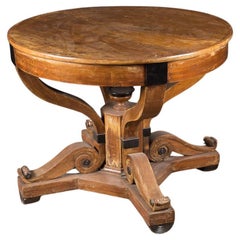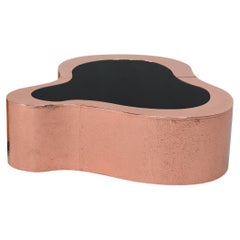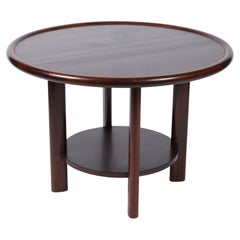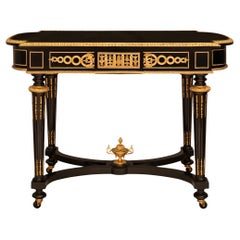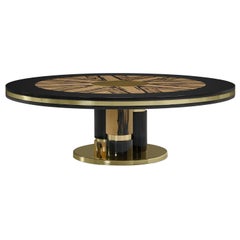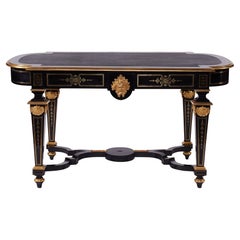Ebony Center Tables
to
5
Height
to
Width
to
Depth
to
36
32
55
20
1
17
7
4
3
3
2
2
2
1
1
1
1
1
6
39
10
21
3
2
4
2
1
1
1,842
4,144
2,250
1,490
1,123
64
24
17
14
10
76
63
70
7
3
3
2
1
Material: Ebony
German 19th Century Period Biedermeier Pedestal Table
Located in New Orleans, LA
Fantastic period round Biedermeier pedestal table made of ebony and walnut. The German antique piece dates back to the early 19th century, circa 1820, and perfectly exemplifies the style and emotion of the era in which it was created. The piece does have some wear on the top.
This piece is a collection of a fourth generation, family owned business in New Orleans called The French Antique Shop. The store was first opened by Marie and Marcel Granet in Paris when they married in 1927. A jewish family, they came to the United States before the outbreak of the Second World War, leaving on the last boat out of Paris' port, Le Havre. When they reached New Orleans, they fell in love with the Vieux Carre...
Category
Early 19th Century German Antique Ebony Center Tables
Materials
Ebony, Walnut
Wave Big Center Table - Hand-Crafted Hammered Brass - Boca do Lobo
Located in Rio Tinto, PT
The Wave Center Table is a statement piece that draws inspiration from coastal rock formations the waves have sculpted, curving their rough shapes th...
Category
2010s Portuguese Ebony Center Tables
Materials
Metal, Brass, Copper, Stainless Steel
$5,800 Sale Price / item
20% Off
1930s French Art Deco Macassar Ebony Circular Centre Table
Located in London, GB
A circular Art Deco centre or large lamp table in solid mahogany with attractively veneered Macassar ebony top and lower tier. French, c. 1930s.
Category
Early 20th Century French Ebony Center Tables
Materials
Ebony, Macassar
French 19th century Louis XVI st. Ebony and Ormolu Boulle side/center table
Located in West Palm Beach, FL
An impressive and most elegant French 19th century Louis XVI st. Ebony and Ormolu Boulle side/center table. This wonderful table is raised on four round tapered and fluted Ebony legs...
Category
19th Century French Louis XVI Antique Ebony Center Tables
Materials
Brass, Ormolu
Ebony Center Table by Memoir Essence
Located in Geneve, CH
Ebony Center Table by Memoir Essence
Dimensions: D 120 x W 120 x H 27 cm.
Materials: Polished brass, lacquer and Royal ebony.
An exquisite combination of royal ebony veneer and blac...
Category
2010s Portuguese Post-Modern Ebony Center Tables
Materials
Brass
$10,083 / item
Noble Napoleon III French Ebony Antique Table Lacquer
Located in Warsaw, PL
"The ebony antique table features the Empire style of the period of King Napoleon III. The Empire style of Napoleon III is marked by grandeur, powerful effects, lavish decoration but...
Category
19th Century French Napoleon III Antique Ebony Center Tables
Materials
Ebony
Antique English William IV Center Breakfast Table w/ Marquetry Inlay Circa 1900
Located in Los Angeles, CA
Circa 1900 Antique William IV Round Pedestal Center / Breakfast Table. Constructed with mahogany, rosewood, satinwood with intricate marquetry and inlays to table top, rising on a ca...
Category
Early 1900s British William IV Antique Ebony Center Tables
Materials
Hardwood, Ebony, Satinwood, Walnut, Rosewood
Secret Garden Round Table in Maple & Ebony, Italian Design by Ivan Paradisi
Located in Turin, IT
The Secret Garden Round Table by Italian designer Ivan Paradisi is a striking example of contemporary collectible furniture where geometry becomes poetry. Entirely handcrafted, the t...
Category
2010s Italian Modern Ebony Center Tables
Materials
Ebony, Maple
A Burr Elm and Ebony Inlay Circular Centre Table
Located in London, GB
A Burr Elm and Ebony Inlay Circular Centre Table
Provenance:
John Murray, Esq. Polmaise Castle, Stirling, Scotland and thence by descent.
Height: 71.5 cm...
Category
Mid-19th Century English George IV Antique Ebony Center Tables
Materials
Ebony, Elm
French 19th Century Louis XVI St. Ebony and Ormolu Center Table
Located in West Palm Beach, FL
An impressive French 19th century Louis XVI st. Napoleon III period ebony and ormolu center table. The table is raised by exceptional and most elegant topie shaped ormolu feet below ...
Category
19th Century French Louis XVI Antique Ebony Center Tables
Materials
Ormolu
19th Century Colonial Ebony and Satinwood Centre Table
Located in Gloucestershire, GB
19th Century Colonial tripod table in solid ebony and satinwood.
The rectangular top over an elegant reeded vase-shaped stem.
An extremely pared-back piece that demonstrates a time...
Category
19th Century Indian Antique Ebony Center Tables
Materials
Ebony, Satinwood
Regency Parcel-Gilt Ebonised Pollard Oak and Brass Centre Table
Located in Palm Desert, CA
Regency parcel-gilt, ebony, ebonised, pollard oak and brass centre table. Attributed to George Bullock, Circa 1815.
Category
Early 19th Century British Regency Antique Ebony Center Tables
Materials
Ebony
French 19th Century Renaissance St. Ebony and Marble Center/Library Table
Located in West Palm Beach, FL
An outstanding and very unique French 19th century Renaissance st. Ebony and marble center/library table. The table is raised by seven elegant circular lightly tapered fluted legs wi...
Category
19th Century French Renaissance Antique Ebony Center Tables
Materials
Marble
Monumental Regency Mahogany in the style of Thomas Hope Centre Table
Located in Shipston-On-Stour, GB
A highly important Regency mahogany and ebony centre table of superior quality, spectacular scale and featuring and in the style of Thomas Hope`s Neo-Classical influences. The circul...
Category
1820s English Regency Antique Ebony Center Tables
Materials
Ebony, Mahogany
A Dutch Colonial 17th century Red Ebony Center table with marble top
Located in Amsterdam, NL
A MOLUCCAN RED EBONY CENTRE TABLE WITH MARBLE TOP
The Moluccas/Ambon, third quarter 17th century
Carved in low-relief with decoration of plant...
Category
Late 17th Century Indian Dutch Colonial Antique Ebony Center Tables
Materials
Marble
Wave Small Center Table - Hand-Crafted Hammered Brass - Boca do Lobo
Located in Rio Tinto, PT
The Wave Center Table is a statement piece that draws inspiration from coastal rock formations the waves have sculpted, curving their rough shapes th...
Category
2010s Portuguese Ebony Center Tables
Materials
Metal, Brass, Copper, Stainless Steel
$4,860 Sale Price / item
20% Off
Recently Viewed
View AllMore Ways To Browse
4 Fold Screen Chinese
Adelaide Antique Furniture
African Chief
African Wood Box
Aircraft Seats
Alabaster Lion
Alan Post
Alexandre Noll Box
Alfredo Barbini Fish
American 1820 Drop Leaf Table
Andre Borderie
Animal Stirrup Cups
Antique 16th Century Plates
Antique 3 Tier Stand
Antique Black Slate Clock
Antique Bridge Tables
Antique Bronze Birds Signed
Antique Burr Walnut Sutherland Table
